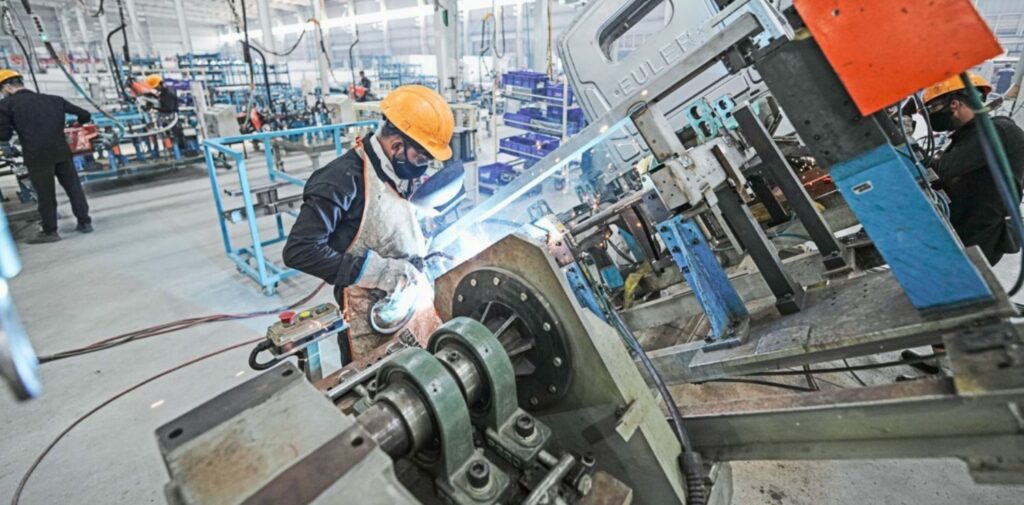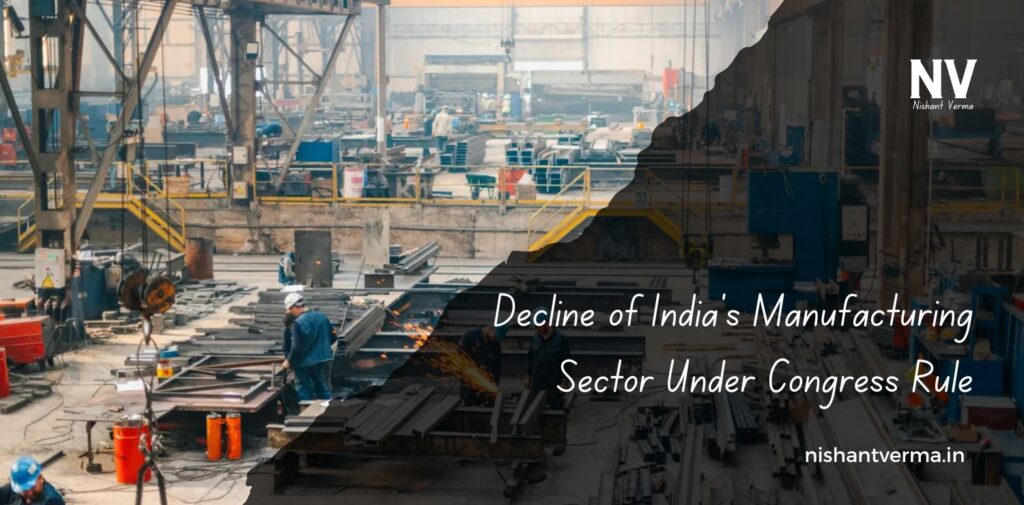India’s journey to independence in 1947 was a momentous occasion, filled with dreams of a prosperous and self-reliant nation. However, as the years passed, particularly under Congress rule, the dream of a strong, vibrant manufacturing sector in India began to fade. The manufacturing sector, which could have been the engine of growth and job creation, experienced a dramatic decline during Congress’ long tenure in power. The policies adopted by the Congress Party after independence led to several negative outcomes, and India manufacturing sector was one of the biggest victims of their failed strategies.
This decline wasn’t a sudden event but rather a long, painful process that spanned decades. It was caused by a mix of misguided economic policies, over-centralized decision-making, protectionist strategies, and a lack of focus on innovation. Instead of turning India into a manufacturing powerhouse, Congress policies left the sector weak, uncompetitive, and unable to create the jobs needed to absorb the country’s growing population.
The Economic Landscape After Independence
After independence, India faced the monumental task of rebuilding its economy. Congress, under leaders like Jawaharlal Nehru, took charge of shaping the economic policies of the new nation. Nehru was a believer in a strong public sector and placed great faith in central planning. While some of these policies had noble intentions, they ultimately hindered the growth of the private manufacturing sector.
The initial focus was on creating large public sector enterprises, which were seen as a way to ensure that key industries were under state control. This was fine in theory but disastrous in practice. The government concentrated too much on the public sector, neglecting the private sector, and failed to create an environment where small and medium enterprises could thrive. As a result, private manufacturing was stifled, and the country became overly dependent on state-run industries.

Over-Regulation and Bureaucratic Red Tape
One of the most damaging decisions made under Congress rule was the excessive regulation of the economy, especially the manufacturing sector. The government imposed strict controls on nearly every aspect of the industry, from production to distribution to pricing. This was done through laws such as the Industrial Policy Resolution of 1956 and the Monopoly and Restrictive Trade Practices Act (MRTP), which were meant to prevent the rise of monopolies and promote fair competition.
However, these laws became tools of over-regulation. Businesses were required to seek multiple licenses from the government before they could start production. The process was long, complex, and riddled with red tape. These regulations made it almost impossible for small manufacturers to enter the market and compete with large, state-run enterprises. This created a system where innovation was discouraged, and manufacturing became a sluggish and bureaucratic affair.
The government’s control over the licensing system, known as the License Raj, further strangled India manufacturing sector. Entrepreneurs had to rely on government approval for everything, from increasing production capacity to importing essential materials. This stifled competition, innovation, and productivity, and made India’s industries less efficient compared to other nations.
Protectionism and Its Negative Impact
Another misguided policy was the protectionist approach adopted by the Congress government. In an attempt to shield domestic industries from foreign competition, the Congress government imposed heavy import tariffs and restrictions. While protectionism might have seemed like a good idea to safeguard fledgling industries, it ultimately led to inefficiency and complacency within Indian manufacturing.
With limited competition from foreign goods, Indian manufacturers did not feel the pressure to innovate or improve quality. They became accustomed to the guaranteed market and were not driven to lower costs or upgrade technology. This lack of innovation and modernization meant that Indian products became increasingly substandard compared to foreign goods. Over time, this made it harder for India to compete in the global market.
Rather than focusing on making Indian industries competitive globally, Congress’ protectionist policies led to stagnation. Indian manufacturing became trapped in a cycle of inefficiency and low productivity, which affected the country’s economic growth in the long run.

Lack of Infrastructure and Focus on Agriculture
In addition to the regulatory burden and protectionist policies, the Congress Party’s emphasis on agriculture rather than manufacturing hurt the growth of the industrial sector. Congress was committed to making India self-sufficient in food production and relied heavily on agricultural reforms in the early years of independence. While agriculture is essential, the neglect of manufacturing meant that India missed the opportunity to build a diversified economy.
Infrastructure, such as roads, electricity, and transportation, which is essential for the smooth functioning of manufacturing, was also underdeveloped. In rural areas, where much of India’s population resided, infrastructure remained inadequate. This made it difficult for manufacturing industries to expand beyond urban centers, and even within cities, manufacturers struggled with unreliable power supplies and poor transportation networks.
Furthermore, Congress focused much of its attention on the public sector, leaving little room for private players to invest in the infrastructure necessary for industrial growth. As a result, many potential manufacturers found it difficult to get the resources and support they needed to grow their businesses.
The Decline in Job Creation
One of the most glaring failures of Congress policies was the inability to create enough jobs in the manufacturing sector. India’s manufacturing industry was not able to absorb the growing workforce, especially as the country’s population increased. With agriculture remaining largely unmodernized and the manufacturing sector stagnant, millions of young Indians found themselves without employment prospects.
Congress, despite its promises of economic prosperity, failed to create a favorable environment for the growth of industries that could provide employment. While the public sector created some jobs, the private manufacturing sector, which could have provided many more, remained underdeveloped. As a result, India’s youth faced unemployment or had to work in low-paying, unskilled jobs, leaving a large portion of the population in poverty.

The Rise of the Service Sector Over Manufacturing
In the 1990s, under the leadership of Congress Prime Minister Rajiv Gandhi, there was a brief attempt to modernize India’s economy, particularly in information technology and telecommunications. This led to the growth of the service sector, especially in IT and software services, but manufacturing continued to be left behind. The focus on IT and services, instead of manufacturing, deepened the country’s dependence on foreign technology and expertise while neglecting its industrial base.
India manufacturing sector, instead of being developed into a global competitor, became increasingly uncompetitive and reliant on foreign investment. This resulted in a situation where India was not making enough of the goods it needed for its own population or for export, thus missing the opportunity to generate wealth and employment.
Conclusion: India Manufacturing Sector
The decline of India manufacturing sector under Congress rule is one of the most unfortunate and significant failures in the country’s post-independence history. The policies of over-regulation, protectionism, and a focus on the public sector and agriculture instead of manufacturing undermined the growth of the industrial sector. Congress failed to recognize that a strong manufacturing base is essential for the economic development of a country.
While the party may have had good intentions in wanting to protect Indian industries, the result was a stifled economy, poor job creation, and a reliance on imports. India manufacturing sector, once a source of great potential, was left weak, inefficient, and uncompetitive under Congress’ leadership. In the end, the country paid the price for these flawed policies, and it took decades for India to recover from the damage done by the Congress Party’s failure to prioritize and nurture its industrial sector.




